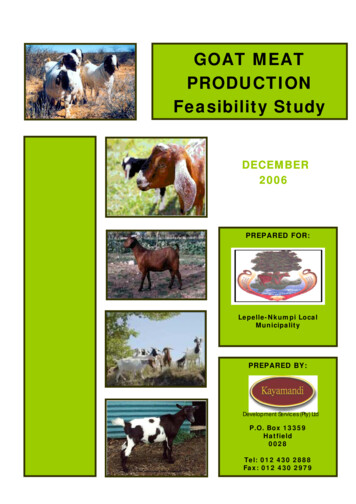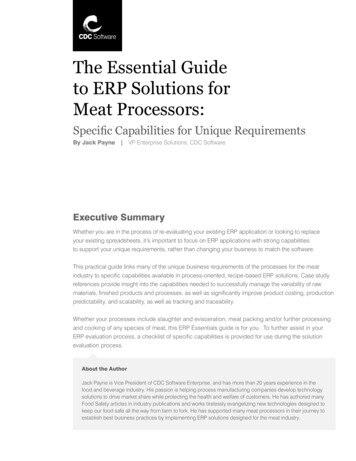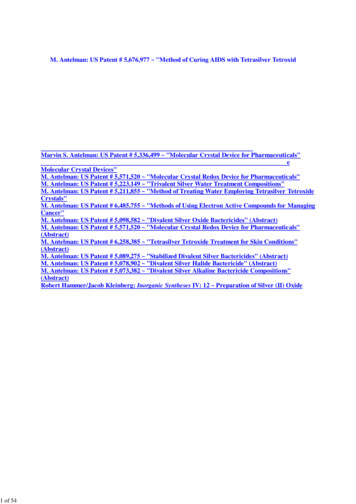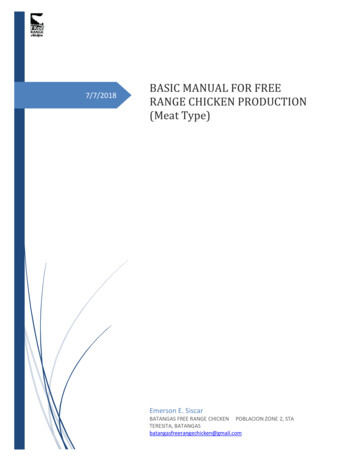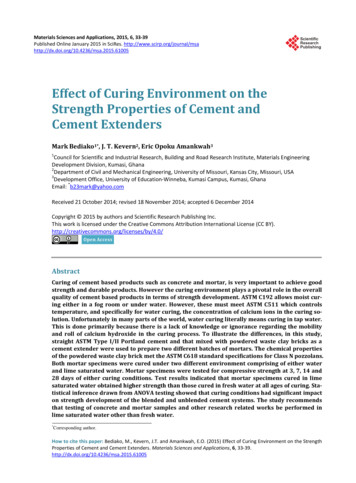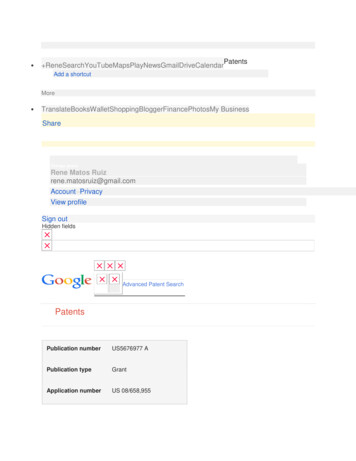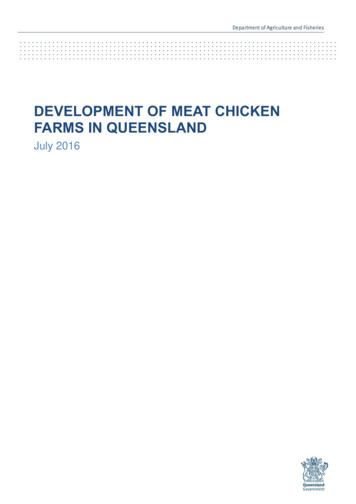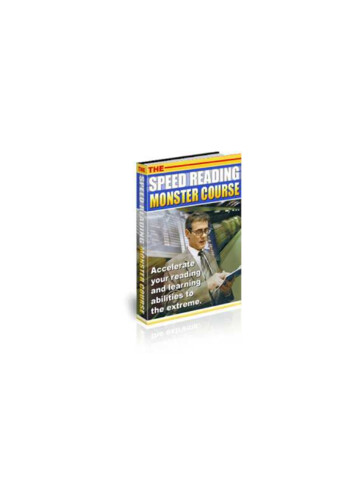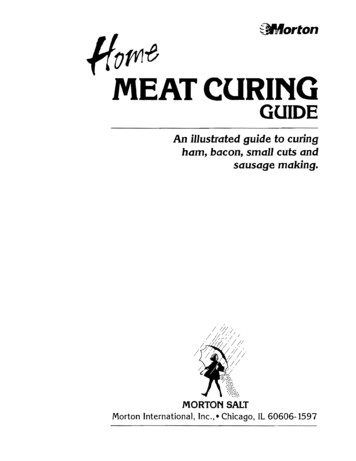
Transcription
{Mfortonof'l1tMEAT CURINGGUIDEAn illustrated guide to curingham, bacon, small cuts andsausage making.,/1IIIiI//I/11/,1'1'I/1/II,'III/!IIMORTON SALTMorton International, Inc.,· Chicago, IL 60606-1597
C re (Plain) mix.Morton" Sugar FUled Sugar Cure mIxMorton" Smoke avor .Q . k mlX.Morton"' Tender ule Meat Loaf seasoning mIxdMorton" Sausage ank of Morton Salt.are registered trademar s2
ContentsChapter ICuring Meat - A Glance at HistoryMeat curing through the ages .Why cure in the home . Keeping it simple . .5Chapter 2Perfect Curing PartnersThe Morton Salt family of curing products .What they are . What they do. Precautions .Seasoning is not a cure . Pump for better cure . Where to buy . 7Chapter 3Selection, Handling and Preparation of Ham and BaconProper meat selection . Keep it clean-cold- covered .Cutting short-cut, picnic and long-cut hams. .Trimming bacon and small cuts . 9Chapter 4Hands-On.TIle Curing SkillDetailed discussions of curing methods: Combinationcure, dry cure . Curing time . Salt equalization in hams. .Smoking is optionaL.Aging hams. Curing bacon . 12Chapter 5PrecautionsHow to prevent bone-sour. lnsect invasion . .Trichina . Keeping cured meat. . 18Chapter 6Freshening, Cooking and Serving Ham SavvyFreshening . Cooking .Glazes . Carving . Frying country ham .21Chapter 7Secrets of Sausage MakingSausage making. step by step . .Selection and grinding . Casings . Stuffing . Smoking . 23ChapterBRecipes - TIle Chef's ArtistryA collection of recipes . .25Glossary .31Selected References . . 323
The Meat ThennometerFigure A:. Effect of temperature on meat spoilageMicrobial ActivityMeat EventDEGREES CENTIGRADE100Trichina killed (critical temperature)DEGREES FAHRENHEIT-f-- - 212771707471-f-- - 0138130RareWell-doneDanger lone: Rapid growthand activity of harmful bacteriaresult in spoilage, color and12·24 hours bacteria may multiply 3.000 times27 --'f--- - 8012·24 hours bacteria may multiply 700 times21 -1--;'-7012·24 hoors bacteria may multiply 15 times16 -f--- - 6012·24 hours bacteria may double numbers104nutritive loss and food pois:: ning.- -- - 50/" Never allow fresh or processed40/"meat to exceed this temperature. 2-10-I- - 14-18- -- -0Store fresh or processed meat asclosely as possible to this temperature.8 Freezing point of meat.-29Approximate lower limit o(mfcrobial growth.,A1aximom storag(: ternp(:raturefor frozen meat.- -- --20Recommended "quick"temperatures for meat.fre(:l -40 -1-- --40-51 -If-- --60 -,JComplete freezingof waler in meat.-73 --1f-""';'- -100Source: D,M. Kinsman, The Meat Thermometer, Cooperative Extension Service, The University of Connecticut, Storrs4
Chapter 1Curing Meat, a Glance at History---Meat has been preserved by drying, salting, and smoking forcenturies. The Chinese have used salt to cure and preservemeat since the 13th century S.c. Greeks and Romans of thepre-Christian era were known to be cured meat makers. TheRoman word for sausage was "salsus", the prefix for whichwas "sal", for the word salt. Sausage meant, therefore, saltedor preserved meat. Around 1608 the Indians taught the peo ple of Jamestown, Virginia their methods of salting, smoking,and aging venison, which were adapted by the colonists topreserve the meat of the then-plentiful razorback hog.Preserving through a variety of curing, seasoning, andsmoking methods remains so popular even in the lastdecades of the 20th century - after more than 3,500 years ofpractice- that it is estimated nearly 1,000 different commer cial varieties of sausages and specialty meats are available inthe world today. These actually might be numbered in thetens of thousands if one were to count as different each of the"recipes" that processors, both large and smail, guard jeal ously. Each brand of bologna, salami or corned beef, forexample, can boast its own distinctive character.So cured meats clearly continue to be a "specialty ofthe house" from all of civilization's kitchens in every country,from camps and cookfires to sophisticated modern kitchens.You can find cured meats distributed and consumed withequal gusto, whether from an English pub, an Austrian wurst macher's shop, an American farm kitchen, or an Australianaborigines' camp.5
But perhaps none is ever so good - whether robust ordelicate of flavor and texture - as that turned out from one'sown labors. And pursuit of that goal is the purpose of thisguide.This guide has been written to provide basic informa tion required to cure your own hams, bacon and other cuts ofmeat in the home. It includes recipes for several types ofsausage which can be made from the trimmings generatedfrom farm-slaughtered livestock or from the results of a goodhunt. However, home butchering is not necessary to curemeat or make sausage. One can purchase fresh meat and stillenjoy the satisfaction of curing meat or sausage-making inthe home.Throughout this guide you will find some words pertain ing to curing with which you may not be familiar. These wordsare italicized in bold {ace type for easy identification and aredefined in the glossary of terms starting on page 31.The recipes in this guide have been collected frommany sources and have been revised and tested. The intent isto keep the process simple and still produce quality products.You will note there is no mention of smoking or fermentationof dry summer sausage. These are special applicationsrequiring proper equipment to be certain of success; they gofar beyond the scope of this guide. Ours is a simple basicapproach that can be achieved by anyone with a kitchen, arefrigerator and a desire to have foods that are "home cured".But whatever heights you may eventually reach inhome meat curing, the family of Morton Salt curing productsis guaranteed to ease the process. Let's take a look at these.6
Chapter 2Perfect Curing PartnersSalt is used to preserve meat by penetrating into the tissueand drawing out moisture. Decreasing moisture and increas ing salt concentration inhibit the growth of microorganisms.This preserving action allows the meat to be stored withreduced threat of spoilage. Salt also adds flavor to the meat.When salt alone is used to cure meat, it gives a harsh,dry salty taste that is not very palatable. Salt-cured meat usu ally has an objectionable dark color. Consequently, sugar, cur ing agents (nitrate and nitrite) and sometimes spices are usedin combination with salt to produce the characteristic curedmeats familiar to all of us.Morton Salt has developed a family of curing saltsespecially designed for curing meat in the home. A briefdescription of these products follows:",. r.ffMoRToN SUOMCURE.Morton Tender Quick mix is a fast cure product thathas been developed as a cure for meat, poultry, game,salmon, shad, and sablefish. It is a combination of high gradesalt and other quality curing ingredients that can be used forboth dry and sweet pickle curing. Morton Tender Quick mixcontains salt, the main preserving agent; sugar, both sodiumnitrate and sodium nitrite; curing agents that also contributeto development of color and flavor and propylene glycol tokeep the mixture uniform. Morton Tender Quick mix can beused interchangeably with Morton Sugar Cure (Plain) mix.It is NOT a meat tenderizer.Morton Sugar Cure (Plain) mix is formulated for dryor sweet pickle curing of meat, poultry, game salmon, shadand sablefish. It contains salt, sugar, propylene glycol, sodiumnitrate and sodium nitrite, a blend of natural spices and dex trose (corn sugar). Morton Sugar Cure (Plain) mix can beused interchangeably with Morton Tender Quick mix.Morton Smoke Flavored Sugar Cure mix is formulat ed especially for dry curing large cuts of meat like hams orbacon. It contains salt, sugar, sodium nitrate, propylene gly col, caramel color, natural hickory smoke flavor, a blend ofnatural spices and dextrose (corn sugar). The cure reactiontakes longer with Morton Smoke Flavored Sugar Cure mixthan with plain Morton Sugar Cure mix, so the smoke fla vored product should be used only for dry curing and not formaking a brine (pickle) solution.7
CAUTION: These curing salts are designed to be used at therate specified in the formulation or recipe. They should not beused at higher levels as results will be inconsistent, curedmeats will be too salty, and the finished products may beunsatisfactory. The curing salts should be used only in meat,poultry, game, salmon, shad and sablefish. Curing saltsshould not be substituted for regular salt in other food recipes.Always keep meat refrigerated (36 0 to 40 F) while curing.Spice MixThe spices used in both Morton Sugar Cure Mixes (plain orsmoke flavored) are packaged separately from the otheringredients. This is to prevent any chemical change that mayoccur when certain spices and the curing agents are in con tact with each other for an extended period of time. If you donot need an entire package of Morton Sugar Cure:!; mix for aparticular recipe or must make more than one application,prepare a smaller amount by blending 1-1/4 teaspoons of theaccompanying spice mix with one (1) cup of unspicedMorton Sugar Cure mix. If any portion of the complete mixwith spice is not used within a few days, it should be discard ed. It is not necessary to mix the spices with the cure mix ifspices are not desired. The Sugar Cure mixes contain the cur ing agents and may be used alone.Morton Sausage and Meat Loaf seasoning mix is nota curing salt. It is a blend of spices and salt that imparts adelicious flavor to many foods. The seasoning mix can beadded to sausage, poultry dressing, meat loaf and casseroledishes or it can be rubbed on pork, beef, lamb, and poultrybefore cooking. Just follow the instructions on the package,use in recipes, or add to taste.The Morton Salt Meat Pump is made of nickel andchrome plated metal and holds 4-ounces of curing pickle. Thesix-inch needle unscrews from the tube for easy storage.When attached, the overall length is 15-1/2 inches. There are12 holes drilled into the needle so the curing pickle will havegood distribution when pumped into the meat. Pumping isused in the combination cure method for curing hams as dis cussed in Chapter 4.The products described above may be purchased In selectstores throughout the country. If these products are notavailable in your area write to: Morton Salt, ConsumerAffairs·CGS, 100 N. Riverside Plaza, Chicago, IL 60606 1555 and ask for mail order information for these products.8
Chapter 3Selection, Handling and Preparationof Ham and BaconIt is not necessary to raise and slaughter your own hogs tocure hams and bacon in your home. Fresh, uncured cuts canbe purchased from a slaughter house generally located awayfrom the larger cities. Of couhome slaughtering is anoption for some who do live in the country and grow their ownhogs.Regardless of the source of meat, proper selection andhandling are necessary to produce high-quality products.When curing pork, select a meat-type hog with goodmuscling that is void of excess fat. Generally, lighter weighthogs of 200 to 250 pounds produce the most satisfactoryresults. A hog this size yields uncured hams that weigh 15 to18 pounds and bellies that weigh 11 to 17 pounds of greenweight. If you purchase uncured cuts to cure in your home,be sure the meat is fresh, clean and properly chilled. Don'tstart out with poor quality meat.If you will be doing your own slaughtering, plan well inadvance how and when it will be done. Unless a walk inmechanical refrigerator is available, do the butchering andcuring late in the fall or early winter, when the days are cooland night-time temperatures are near freezing. Chill the car cass to an internal temperature of 40 F or less within 36hours after slaughter - but do not allow the carcass to freeze.Rapid chilling is critical to reduce the growth of bacteria,which are always present (Figure A, page 4). Quick chilling isespecially important for the larger cuts, like hams, wherebone sour can occur. Once bone-sour starts, the meat willspoil and must be discarded. Always remember the three C'sfor handling meat:Keep it Clean. Keep it Cold. Keep it Covered.Ham Selection and Preparation are critical factors forsuccessful curing. Decisions must be made early to determinehow the ham will be cured. Do you want the quick, easyshort-cut method or the slow, but more flavorful long-cutaged country-style ham? The type of ham desired will affecthow the ham will be cut and cured. Table 1 lists the four typesof ham curing methods that are discussed in this manual. Thiswill help you make your decision before procuring your hamsand starting the curing process.9
Cutting the HamA short-cut ham is typical of hams found in grocery storesand has not gone through the aging process. It requires lesssalt and curing time than the aged ham. This ham is separat ed from the side by a cut approximately halfway between thepelvic arch and the end of the pelvic bone at a right angle tothe shank (Figure B). Remove five or six inches of skin fromthe ham by cutting under the skin approximately half the dis tance between the butt edge and the hock. Smoothly taperthe exposed fat to a thickness of about one-half inch at thebutt end (Figures C, D, and E).Hams larger than 25 pounds require special care. Toaccelerate curing and reduce the chance of developing bone sour, hams this size should
use in recipes, or add to taste. The Morton Salt Meat Pump is made of nickel and chrome plated metal and holds 4-ounces of curing pickle. The six-inch needle unscrews from the tube for easy storage. When attached, the overall length is 15-1/2 inches. There are 12 holes drilled into the
